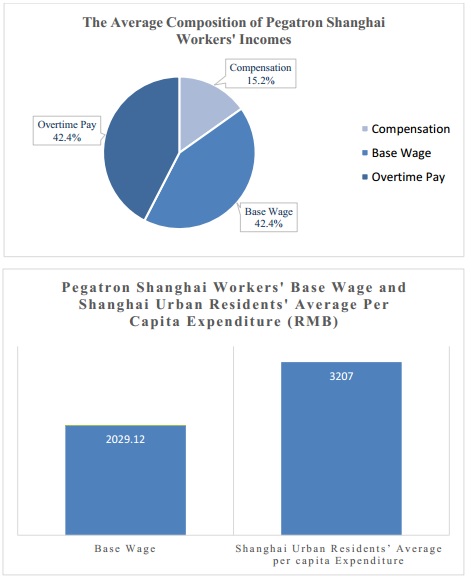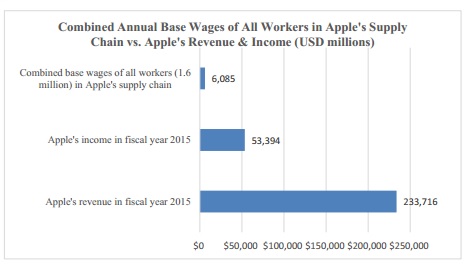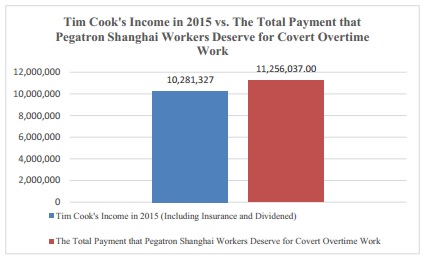Study Casts Doubts on Apple’s Ethical Standards
For CLW Response to Bloomberg's report on Pegatron, please visit the link.
Introduction
In 2013, China Labor Watch (CLW) began investigating the labor conditions of workers at Pegatron Corporation factories in China making products for Apple. In February 2015, CLW published a research report based on analysis of 96 pay stubs collected from workers of Pegatron Shanghai, discovering difference between the working hours which Apple publicly promotes and the reality on the production line.
This year, CLW collected 1,261 pay stubs from Pegatron Shanghai workers, 13 times as many as stubs as last year. The documents were gathered with the assistance of 18 Pegatron workers coming from 12 departments, who in turn collected pay stubs from workers of many other departments. Of the 1,261 pay stubs collected, 1,122 valid pay stubs were from the months of September and October 2015, which are in the busy season for iPhone production at Pegatron. Among those pay stubs, 1,035 were from October; in a factory of 70,000, the sample error is 1% at a 99% confidence interval. (Pay stub raw data.)
CLW used data from the pay stubs, especially for the months of September and October, to calculate wages and working hours for Pegatron workers. Results of this research demonstrate that workers making Apple products continue to work tremendous amounts of overtime in order to make up for their minimum wage compensation. A worker surnamed Zhou told CLW, “When it is busy, we have to work very long hours and take only one or two days off each month. Sometimes we cannot stand it and ask for leave, but it’s not granted.” Another worker surnamed Zhang said “Wages aren’t enough to live without overtime pay. I will quit if monthly wages drop below 4,000 RMB ($612).”
This report seriously questions Apple's sustainability reporting. CLW’s findings suggest severe discrepancies between what Apple tells the public and its investors about the working hours of workers making its products and the reality on the production line. The discrepancies in Apple's claimed working conditions and actual working conditions are important not only because they highlight problems in Apple's monitoring. The findings also clarify that despite being the most profitable company in history, Apple does not raise the bar to a commensurate level for workers making its products. They still earn minimum wage. They still depend on tremendous overtime to make ends meet.
The following are the primary findings of this report, followed by a summary, methodology, and a more detailed report.
Primary Findings
1) Workers are paid at a rate of 1.82 USD/hour.
2) On average, overtime pay as a percentage of workers’ gross wages is 42.4%.
3) Workers work more than 10 hours a day, 6 days a week. 83.8% workers’ monthly overtime hours exceed 80 hours.
4) In October 2015, 71.1% of workers’ average weekly working hours exceeded Apple 60-hour maximum limit.
5) Pegatron Shanghai workers must participate in an average of 15 minutes of mandatory pre- and post-shift meetings every day, or 90 minutes per week. If we assume that Pegatron Shanghai workers all have hidden, unpaid overtime, as CLW interviews suggest, then the total unpaid wages amount to US$11.85 million
6) The total value of Tim Cook’s stock growth up to February 2016 is equal to the combined annual base wages of 78,847 Pegatron workers.
7) The combined base wages of 1.6 million workers on Apple’s supply chain only accounts for 2.6% of Apple annual revenues.
Report Summary
1. The base wage paid to workers on Apple’s production line is too low, so workers need do excessive overtime work to support their lives in Shanghai.
· Overtime pay as a percentage of workers’ gross income is as high as 42.4%.
· The base wage (the local minimum wage) alone is not enough to meet workers’ living expenses in Shanghai.

Note: According to Shanghai Statistic Administration’s statistics, Shanghai urban residents’ average per capita expenditure in 2014 was 2,543 RMB, but the housing expenses (253 RMB) do not include house purchases or construction costs. Most workers are residents of other regions and cannot purchase housing, so living expenses were replaces with rent of 917 RMB, the value of the average rent in Shanghai Pudong District (location of Pegatron facility). 2,543 RMB – 253 RMB + 917 RMB = 3,207 RMB. Because the Shanghai Statistics Administration has not released the 2015 data yet, we used the 2014 expenditure data of Shanghai urban residents.
2. The weekly working hours and monthly overtime hours of workers on Apple’s production line far exceed the upper limits set Chinese law as well as statistics published by Apple.
· Chinese Labor Law requires that monthly overtime hours not exceed 36 hours, but at Pegatron Shanghai, only 1.1% of workers’ overtime hours are within this limit.
· In Apple’s “Supplier Responsibility 2015 Progress Report”, it is stated that in 2014, 92% of all workweeks were compliant with its 60-hour workweek standard set out by Apple. But according to pay stubs of Pegatron Shanghai workers in October 2015, 71.1% of workers’ average weekly working hours exceeded this limit.
Note: On the “Supplier Responsibility” segment of Apple’s website, Apple has posted a record of working hours in its supply chain from September and October 2015. Because Apple does not provide specific percentages in the chart, the “10%” and “9%” provided here are CLW’s conservative estimates. For details of Apple’s statistics, please see Figure 2.2c.
3. Apple’s profit distribution is severely imbalanced; it must take more responsibility to improve labor conditions
· Tim Cook’s stock bonus in 2011 was equivalent to the combined annual base wages of 98,862 Pegatron Shanghai workers, even though Pegatron only employs approximately 70,000 workers.[1]
· Apple earns sufficient profits to improve labor conditions. But if we assume that all 1.6 million workers in Apple’s supply chain (a number provided in Apple’s official report) earn the same base wage as Pegatron workers (which is the local minimum wage in Shanghai), the combined annual wages of all 1.6 million workers only equals 2.6% of Apple’s total revenue in fiscal year 2015. Apple’s efforts to protect labor rights are very limited.
Note: Tim Cook’s estimated stock returns are calculated according to Apple’s stock price. The value of Tim Cook’s stock growth at a given date is equal to: 376 million USD*stock price at given date/stock price on Aug 24 2011 - 376 million USD. For Apple’s stock price, please refer to http://www.msn.com/en-us/money/stockdetails?symbol=US:AAPL.

Note: The combined annual base wages of “all workers in Apple’s supply chain” is an estimate based on most (96.9%) Pegatron Shanghai workers’ individual annual base wage, 24,240 RMB, or $3,803.
4. Workers’ Hidden Weekly Overtime Hours are Not Paid
- According to CLW’s discussions with over 100 Pegatron workers and research on pay stubs in both September and October 2015, Pegatron Shanghai workers must participate in an average of 15 minutes of mandatory pre- and post-shift meetings every day, or 90 minutes per week. However, all of the workers interviewed expressed that the meetings are not included in their paid working time. Thus, workers’ actual weekly working time is 90 minutes (1.5 hours) longer than that written on their pay stubs.
- If we assume that Pegatron Shanghai workers all have hidden, unpaid overtime, as CLW interviews suggest, then the total unpaid wages amount to US$11.85 million, greater than Tim Cook’s 2015 annual income. (Note that this estimate is calculated based on workers’ hidden overtime work in September and October 2015, which is the busy season.)
- One male worker surnamed Zhang said, “In many departments, workers have meetings in the morning and evening before and after their shifts. It is said that we begin working at 8 am, but the meeting and attendance check start at about 7:40 am. We have meetings after working too, and all these are not calculated in working hours.”
- Taking the 1.5 hours of weekly unpaid overtime into consideration, the real circumstance for excessive overtime work is shown in the figures below. Note that after including unpaid overtime, nearly none of the workers at Pegatron have monthly overtime hours at or below the maximum set out by Chinese labor law.
Note: “+ hidden overtime” includes the daily meeting time (15 minutes a day, or 1.5 hours a week) in the calculation of weekly working hours, so the actually working hours under this calculation are 1.5 hours longer than the those under “Simple Calculation”. “+ hidden overtime & holidays” takes into account both daily hidden overtime as well as national holidays in September and October. If we assume a 5 regular work days in a workweek, then the weekly working hours formula is equal to: monthly overtime hours/(statutory working days in this month/5)+40 hours+1.5 Hours.

Note: In Apple’s fiscal year 2015 (September 27, 2014 to September 26, 2015), there are 248 statutory working days. Taking the 15 minutes of unpaid daily meeting time into account, each worker has 62 hours of annual hidden overtime work with an overtime wage of 17.4 RMB ($2,61) per hour, or 1,078.8 RMB ($162) of unpaid overtime wages per person for the entire year. Based on approximately 70,000 workers at Pegatron Shanghai workers, assuming all of them have unpaid hidden overtime hours, combined unpaid hidden overtime wages are 75,516,000 RMB, or $11,848,460.
Methodology
With the help of 18 workers/investigators, China Labor Watch collected 1161 pay stubs from Pegatron Shanghai in November and December. The workers/investigators work at different departments, and the pay stubs include employees of different positions and in different departments. Among the 1161 pay stubs, 1121 of them are in September and October, and 1061 are in October. According to our research and analysis, we believe these pay stubs can to a certain degree reflect workers’ wage and overtime work situation in Pegatron Shanghai. (Excel sheet with all raw data.) In addition to gathering pay stubs, China Labor Watch also conducted interviews with Pegatron workers.
Mingwei Liu (Associate Professor of Labor Studies and Employment Relations at Rutgers University) said the following about the methodology of this report:
“Multinational companies' CSR audits have been widely criticized for their inaccuracy and ineffectiveness. The latest report of CLW on working conditions in Apple's supplier Pegatron further strengthens this criticism. The data collected by CLW are impressive. Although the workers were not randomly sampled, the investigation methodology is reasonable and in fact often used by researchers due to the lack of sincere cooperation of employers. In my view, the data have good quality and reliability and the findings are largely consistent with the existing literature on factory conditions in China. All in all, this report will help us better understand the reality of working conditions at the Chinese end of electronics supply chains.”
 One of 1,261 pay stubs from Pegatron workers collected by CLW for this report
One of 1,261 pay stubs from Pegatron workers collected by CLW for this report
We sent our 2015 report about Apple's supplier-Pegatron's labor abuses to Apple in October 2015, but have not received any response yet.
[1] Base wage = gross income - overtime pay – compensation. In Pegatron Shanghai, the base wage is equal to the local minimum wage of 2020 RMB (US$303/month, or 1.82US$/hour). The average monthly gross income is 4895 RMB (US$734).